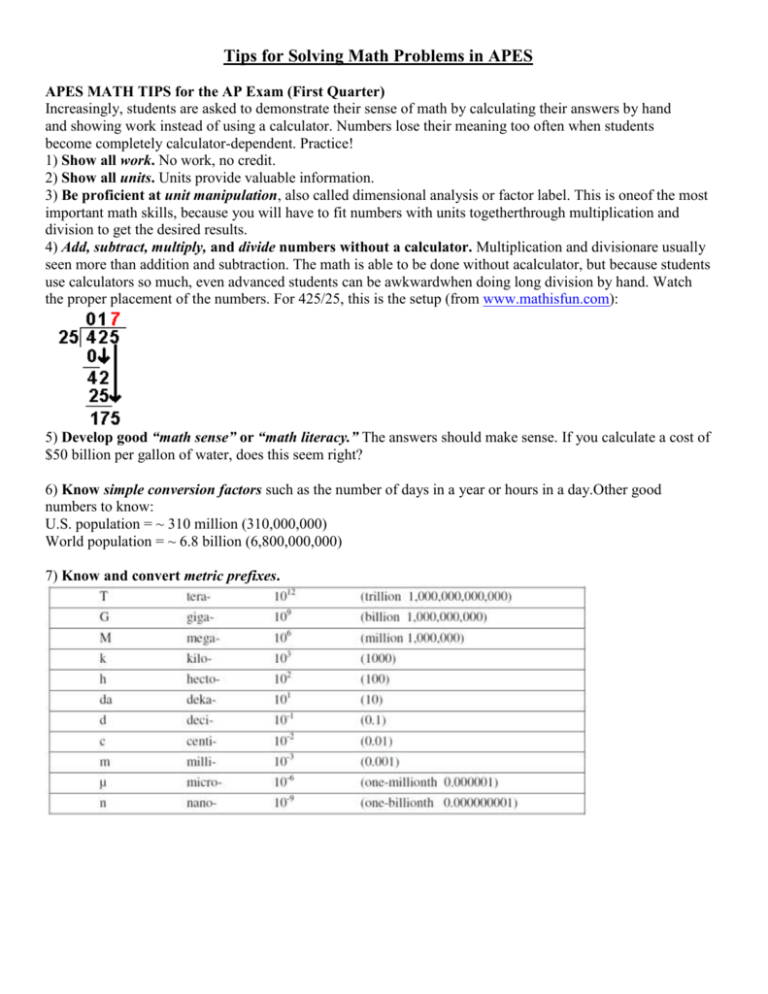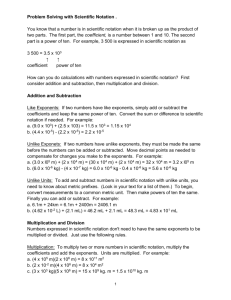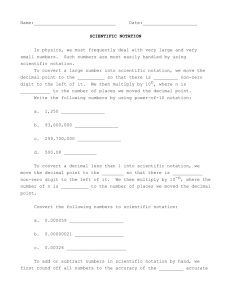Midterm math Review
advertisement

Tips for Solving Math Problems in APES APES MATH TIPS for the AP Exam (First Quarter) Increasingly, students are asked to demonstrate their sense of math by calculating their answers by hand and showing work instead of using a calculator. Numbers lose their meaning too often when students become completely calculator-dependent. Practice! 1) Show all work. No work, no credit. 2) Show all units. Units provide valuable information. 3) Be proficient at unit manipulation, also called dimensional analysis or factor label. This is oneof the most important math skills, because you will have to fit numbers with units togetherthrough multiplication and division to get the desired results. 4) Add, subtract, multiply, and divide numbers without a calculator. Multiplication and divisionare usually seen more than addition and subtraction. The math is able to be done without acalculator, but because students use calculators so much, even advanced students can be awkwardwhen doing long division by hand. Watch the proper placement of the numbers. For 425/25, this is the setup (from www.mathisfun.com): 5) Develop good “math sense” or “math literacy.” The answers should make sense. If you calculate a cost of $50 billion per gallon of water, does this seem right? 6) Know simple conversion factors such as the number of days in a year or hours in a day.Other good numbers to know: U.S. population = ~ 310 million (310,000,000) World population = ~ 6.8 billion (6,800,000,000) 7) Know and convert metric prefixes. 8) Know that “per capita” means per person; per unit of population. . 9) Be comfortable working with negative numbers. Going from -8 ºC to +2 ºC is a 10º change. 10) Recognize units of area and volume, and be able to convert volumes. 1 m = ____ mm… answer _ 1000 1 m3 = ____ mm3 answer _ 13 m3 = 10003 mm3 (103)3 = 109 mm3 For area conversions, square the number, square the unit. For volume conversions, cube the number, cube the unit. 11) Calculate percentages. Example: 80/200 = 40/100 = 0.4 = 40% 12) Put very large or very small numbers into scientific notation. 310,000,000 = 310 million = 310 x 106 = 3.1 x 108 0.000 000 000 000 097 = 9.7 x 10-14 13) Work scientific notation problems without a calculator. Multiplication and division will be common. Multiplying numbers in scientific notation requires the exponents to be added. Dividing numbers in scientific notation requires exponents to be subtracted. Scientific Notation 1. Converting to Scientific Notation: 0.00234 = 2.34 x 10-3 Write the number .00234 as a coefficient. Coefficients need to be between 1 and 10. The coefficient is then multiplied by ten raised by an exponent. The number of places to the left that you move the decimal point is the exponent. If you move the decimal to the right, the exponent will be negative. = 0.0234/10 = 0.234/ (10 x 10) = 2.34 / (10 x 10 x 10) = 2.34 / (103) = 2.34 x 10-3 2. Adding and subtracting two numbers written in scientific notation: 5.2 x 103 + 3.6 x 104 = 4.12 x 104 Factor out one of the powers of ten; usually the smaller one is the easiest. Divide both numbers by the power of ten and multiplying the whole quantity by the same power of ten. To divide one power of ten by another, simply subtract the two exponents. Next, convert the two numbers from scientific notation to real numbers. Now add the two numbers normally. Finally convert to scientific notation if the coefficient is less than 1 or greater than 10. 5.2 x 103 + 3.6 x 104 = (5.2 x 103/103 + 3.6 x 104/103) x 103 = (5.2 x 100 + 3.6 x 101) x 103 = (5.2 + 36) x 103 = 41.2 x 103 = 4.12 x 104 3. 9 x 10-6 – 6.9 x 10-5 = -6.51 x 10-5 Factor out one of the powers of ten. Next, convert both scientific notation numbers to real numbers. Subtract the two numbers normally and convert to scientific notation if the coefficient is not between 1 and 10 (or -1 and -10). 3.9 x 10-6 – 6.9 x 10-5 = (3.9 x 10-6/10-5 – 6.9 x 10-5/10-5) x 10-5 = (3.9 x 10-1 – 6.9 x 100) x 10-5 = (.39 – 6.9) x 10-5 = -6.51 x 10-5 3. Multiplying two numbers written in scientific notation: (4 x 10-2) x (2 x 1010) = 8 x 108 Multiply the two coefficients and then multiply the two powers of ten by adding their exponents: since -2 + 10 = 8, then 10-2 x 108. Finally, combine your two answers and convert to scientific notation: 8 x 108. (4 x 10-2) x (2 x 1010) = (4 x 2) x (10-2 x 1010[add]) = (8) x (108) = 8 x 108 2 4. Divide two numbers written in scientific notation: (4.2 x 10-6) / (6 x 10-2) = 7 x 10-5 Divide the two coefficients: 4.2/6 = 0.7. Then, divide the two powers of ten by subtracting their exponents: Since -6 – (-2) = -6 + 2 = -4, then 10-6/10-2 = 10-4. Finally, combine your two answers and convert to scientific notation. (4.2 x 10-6) / (6 x 10-2) = (4.2/6) x 10-6/10-2 [subtract]) = (0.7) x (10-4) = 7 x 10-5 14) Percent change is the (original number-new number) X 100 Original 15) Rule of 70 to predict doubling time. Calculates the doubling time based upon a percentage. 70 = years to double % growth (do not convert to a decimal) Doubling time = 70 / annual growth rate (in %, not decimal!) Example: If a population is growing at a rate of 4%, the population will double in 17.5 years. (70 / 4 = 17.5) 16) Dimensional analysis or Conversions How many seconds are in a day? Here's your first problem: 1. Ask yourself, "What units of measure do I want to know or have in the answer?" In this problem you want to know "seconds in a day." After you figure out what units you want to know, translate the English into Math. Math is a sort of shorthand language for writing about numbers of things. If you can rephrase what you want to know using the word "per," which means "divided by," then that's a step in the right direction, so rephrase "seconds in a day" to "seconds per day." In math terms, what you want to know is: 2. Ask, "What do I know?" What do you know about how "seconds" or "days" relate to other units of time measure? You know that there are 60 seconds in a minute. You also know that in 1 minute there are 60 seconds. These are two ways of saying the same thing. You know that there are 24 hours in a day (and in one day there are 24 hours). If you could now connect "hours" and "minutes" together you would have a sort of bridge that would connect "seconds" to "days" (seconds to minutes to hours to days). The connection you need, of course, is that there are 60 minutes in an hour (and in one hour there are 60 minutes). When you have this kind of connection between units, then you know enough to solve the problem--but first translate what you know into math terms that you can use when solving the problem. If in doubt, write it out: All of these statements, or conversion factors, are true or equivalent (60 seconds = 1 minute). All you need to do now is pick from these statements the ones that you actually need for this problem, so.... 3. Ask, "From all the factors I know, what do I need to know?" Remember that you want to know: So pick from the things you know a factor that has seconds on top or day(s) on the bottom. You could pick either of the following two factors as your "starting factor:" Write down your starting factor (say you pick 60 seconds per 1 minute): Now the trick is to pick from the other things you know another factor that will cancel out the unit you don't want. You start with "seconds" on top. You want "seconds" on top in your answer, so forget about the seconds—they're okay. The problem is you have "minutes" on the bottom but you want "days." You need to get rid of the minutes. You cancel minutes out by picking a factor that has minutes on top. With minutes on top and bottom, the minutes will cancel out. So you need to pick 60 minutes per 1 hour as the next factor because it has minutes on top: You now have seconds per hour, since the minutes have cancelled out, but you want seconds per day, so you need to pick a factor that cancels out hours: 4. Solve it. When you have cancelled out the units you don't want and are left only with the units you do want, then you know it's time to multiply all the top numbers together, and divide by all the bottom numbers. In this case you just need to multiple 60x60x24 to get the answer: There are 86,400 seconds in a day. Here's how this problem might look if it were written on a chalkboard: Remember that you don't need to worry about the actual numbers until the very end. Just focus on the units. Plug in conversion factors that cancel out the units you don't want until you end up with the units you do want. Only then do you need to worry about doing the arithmetic. If you set up the bridge so the units work out, then, unless you push the wrong button on your calculator, you WILL get the right answer every time. 18) Understand common statistical terms. The mean is the mathematical average. The median is the 50th percentile, which is the middle value in the distribution of numbers when ranked in increasing order. The mode is the number that occurs most frequently in the distribution 19 Calculate percent change: a) The rate of change from one period to another = [(Vpresent - Vpast) / Vpast] * 100 (where V = value) b) Annual rate of change: take answer from step a) and divide by the number of years between past and present values Example: A particular city has a population of 800,000 in 1990 and a population of 1,500,000 in 2008. Find the growth rate of the population in this city: Growth Rate = (1,500,000 - 800,000) / 800,000 * 100 = 700,000/800,000 * 100 = 87.5% Average Annual Growth Rate = 87.5% / 18 years = 4.86 % 20) Graphing tips: include a title and key; set consistent increments for axes; connect dots; interpolate and extrapolate; be comfortable with graphing by hand. Second Quarter 17)Population Growth Rate Growth rate is calculated by the change in the population divided by the total population, then multiplied by 100 to report the change in a percentage. When given the CBR and the CDR use the following equation: CBR – CDR = % 10 14) Know growth rate calculations. Growth rate = [CRUDE BIRTH RATE + immigration)]– [(CRUDE DEATH RATE + emigration)] (see 2003 FRQ #2) CBR = crude birth rate = # births per 1000, per year CDR = crude death rate = # deaths per 1000, per year (CBR – CDR) / 10 = percent change










